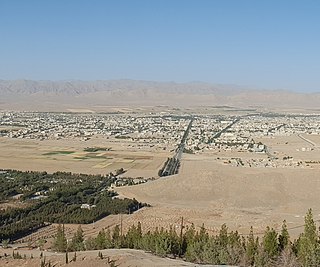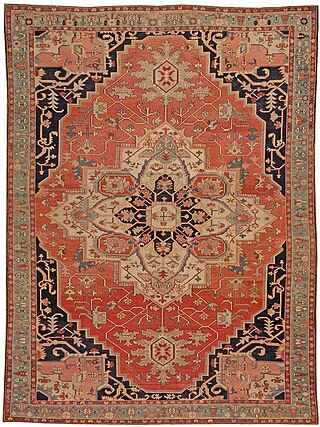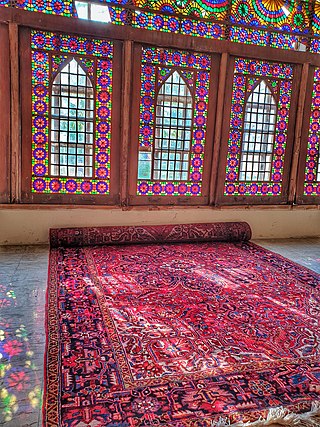
An Abaadeh carpet is a type of Persian carpet made in the town of Abadeh in Iran.

An Abaadeh carpet is a type of Persian carpet made in the town of Abadeh in Iran.
The rugs are named after the city of Abadeh, halfway between Isfahan and Shiraz in Iran, where these rugs are made. [1]
The rugs often feature a large diamond pattern in the centre, with smaller ones in the corners also. [1]

Abadeh is a city in the Central District of Abadeh County, Fars province, Iran, serving as both capital of the district and of the county.

A carpet is a textile floor covering typically consisting of an upper layer of pile attached to a backing. The pile was traditionally made from wool, but since the 20th century synthetic fibers such as polypropylene, nylon, or polyester have often been used, as these fibers are less expensive than wool. The pile usually consists of twisted tufts that are typically heat-treated to maintain their structure. The term carpet is often used in a similar context to the term rug, but rugs are typically considered to be smaller than a room and not attached to the floor.

A Persian carpet or Persian rug, also known as Iranian carpet, is a heavy textile made for a wide variety of utilitarian and symbolic purposes and produced in Iran, for home use, local sale, and export. Carpet weaving is an essential part of Persian culture and Iranian art. Within the group of Oriental rugs produced by the countries of the "rug belt", the Persian carpet stands out by the variety and elaborateness of its manifold designs.

Gabbeh or gabba carpets are a traditional variety of Persian carpet. Gabbeh is known as gava in Kurdish and Luri and is also called khersak (خرسک) in Bakhtiari, literally meaning a "bear's cub". Traditionally a sleeping rug, a gabbeh is a hand-woven pile rug of coarse quality and medium size characterized by an abstract design that relies upon open fields of color and a playfulness with geometry. This type of rug is popular among the populations of the Zagros Mountains of Iran, including Kurdish, Luri and Qashqai people. The gabbeh is usually crafted by women.

A Shiraz carpet is a type of Persian rug made in the villages around the city of Shiraz, in the Iranian province of Fars.

A Tabriz rug or carpet is a type in the general category of Persian carpets from the city of Tabriz, the capital city of East Azerbaijan province in northwest of Iran. It is one of the oldest rug weaving centers and makes a huge diversity of types of carpets. The range starts at Bazaar quality of 24 raj and on up to the incredibly fine 110 raj. Raj is the unit of knot density. It shows the rigidity of the rug which based on the number of strings used for the foundation of the rug. Strings materials are usually made of cotton or silk which is used for very fine rugs.
An oriental rug is a heavy textile made for a wide variety of utilitarian and symbolic purposes and produced in "Oriental countries" for home use, local sale, and export.

Heriz rugs are Persian rugs from the area of Heris, East Azerbaijan in northwest Iran, northeast of Tabriz. Such rugs are produced in the village of the same name in the slopes of Mount Sabalan. Heriz carpets are durable and hard-wearing and they can last for generations. 19th century examples of such carpets are often found on sale by major auction houses in United States and Europe. Part of the reason for the toughness of Heriz carpets is that Mount Sabalan sits on a major deposit of copper. Traces of copper in the drinking water of sheep produces high quality wool that is far more resilient than wool from other areas. The Heris Carpet is the only carpet in the world where stories of the Old times are woven.

Qom rugs are made in the Qom Province of Iran, around 100 km south of Tehran. Although rug weaving in Qom was not a major industry until the past 100 years, the luxurious silk and wool rugs of Qom are known for their high quality and are regarded among the most expensive in the world. Persian Qum rugs are often considered as investment, because their value is constantly increasing.

The Ahar rug, also called Ahar carpet, is a type of Persian carpet made in the town of Ahar in Ahar County is the capital of Karadag Khanate in Iran.
Iranian handicrafts are handicraft or handmade crafted works originating from Iran.

A Turkmen rug is a type of handmade floor-covering textile traditionally originating in Central Asia. It is useful to distinguish between the original Turkmen tribal rugs and the rugs produced in large numbers for export mainly in Pakistan and Iran today. The original Turkmen rugs were produced by the Turkmen tribes who are the main ethnic group in Turkmenistan and are also found in Afghanistan and Iran. They are used for various purposes, including tent rugs, door hangings and bags of various sizes.

Sarab is a city in the Central District of Sarab County, East Azerbaijan province, Iran, and serves as capital of the county. At the 2006 census, its population was 42,057 in 11,045 households. The following census in 2011 counted 44,846 people in 13,353 households. The latest census in 2016 showed a population of 45,031 people in 13,953 households.
An Afghan rug is a type of handwoven floor-covering textile traditionally made in the northern and western areas of Afghanistan, mainly by Afghan Turkmens and Uzbeks. The industry is being expanded to all 34 provinces of Afghanistan.

Armenians wove Lilihans in Lilihan village in what used to be called Kamareh district in Iran. The term Lilihan is better known in the US, in Europe it is not as widely used.

Caucasian carpets and rugs are primarily made in villages, rather than in cities. They are made from materials particular to individual tribal provinces, the rugs of the Caucasus normally display bold geometric designs in primary colors. Styles typical to the Caucasus region are Daghestan, Verne, Shirvan, Ganja, Kazakh, Karabagh, and Quba rugs. Several carpet styles from contemporary northwestern Iran also fall largely into this bracket, such as the Ardabil rugs.
A Sarouk rug is a type of Persian rug from Markazi Province in Iran. Sarouk rugs are those woven in the village of Saruk and also the city of Arak and the surrounding countryside.
Varamin carpets and rugs or Veramin carpets and rugs are carpets and rugs woven in city of Varamin and its surrounding area, southeast of Tehran. Many rug and carpet experts see Varamins as being among those Persian carpets most authentic in terms of traditional style and motif.
The Bakhtiari rug, along with other weavings, is a major artform of the Bakhtiari tribe, located in Chahar Mahaal and Bakhtiari, Iran. Since the early 19th century, Bakhtiari rugs have been exported around the world.

A pictorial carpet, picture carpet, tableau rug, carpet tableau or rug tableau is an ornamental rug specially prepared for hanging on room and hall walls for decoration. The designs and samples on pictorial carpets are completely different from those on common floor rugs. Pictorial carpets are generally made of silk but they have also been made from wool. Pictorial carpets are usually framed to sell and use.